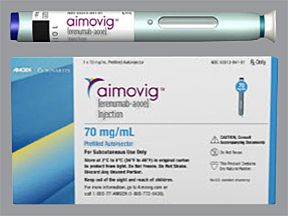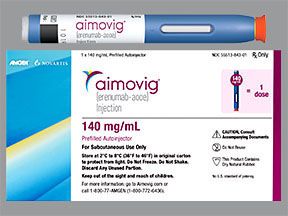The usual Aimovig dosage for migraine prevention is a 70-milligram (mg) injection or a 140-mg injection, once per month. Your dosage may depend on your migraine symptoms.
Aimovig is used in adults to help prevent migraine episodes.
The active ingredient in Aimovig is erenumab-aooe. Aimovig belongs to a group of drugs called calcitonin gene-related peptide inhibitors.
This article describes the dosage for Aimovig injections, as well as its strengths and dosing frequency. To learn more about Aimovig, refer to this in-depth Aimovig article.
The following chart highlights the basics of Aimovig dosage. Be sure to read on for more detail. And, always take the dosage your doctor prescribes for you. They’ll determine the best dosage to fit your needs.
| Aimovig forms | Aimovig strengths | Typical dosage | Maximum dosage |
|---|---|---|---|
| • a single-dose prefilled SureClick auto-injector pen • a single-dose prefilled syringe | • 70 milligrams per 1 milliliter (mg/mL) of liquid solution • 140 mg/mL | 70 mg once per month | 140 mg once per month |
Aimovig forms
Aimovig comes as a liquid solution that you’ll inject under your skin using one of these devices:
- a single-dose prefilled SureClick auto-injector pen
- a single-dose prefilled syringe
Aimovig strengths
The Aimovig SureClick pen and the syringe each come in two strengths:
- 70 mg/mL
- 140 mg/mL
The usual starting dosage of Aimovig is 70 mg once per month. If this dosage doesn’t reduce your number of migraine episodes or migraine symptoms enough, your doctor may increase your dosage to 140 mg once per month.
These dosages are commonly used or recommended, but be sure to take the dosage your doctor prescribes for you.
Is Aimovig taken long term?
Yes, Aimovig is usually taken as a long-term treatment if it’s working to help prevent your migraine symptoms. If you and your doctor agree that Aimovig is safe and effective for you, it may be prescribed long term.
What if I miss a dose?
If you miss an injection of Aimovig, take it as soon as you remember. Be sure to adjust your dosing schedule so that your next dose is a month away, since Aimovig is injected once per month.
Do not give yourself two doses of Aimovig at one time. This could increase your risk of serious side effects.
The following are answers to some commonly asked questions about Aimovig’s dosage.
Can I take Aimovig a few days early?
Yes, it’s OK to inject Aimovig a few days early. Be sure to adjust your dosage schedule so that your next dose is 1 month away. And, keep in mind that injecting Aimovig early might raise your risk of or worsen side effects.
Be sure to follow the dosage schedule that your doctor prescribes.
Should I take Aimovig every 28 days?
Yes, you should inject Aimovig once per month, or about every 28 days. Aimovig’s manufacturer recommends taking the drug once per month. This is because Aimovig’s half-life (the time it takes for half of a dose to be cleared from your body) is 28 days.
Aimovig is an injectable liquid solution that comes in a prefilled syringe or a prefilled SureClick auto-injector pen.
Your doctor or another healthcare professional will show you (or a caregiver) how to give yourself injections at home. Some things to consider include the following:
- Before injecting a dose of Aimovig, remove it from the refrigerator and let it sit at room temperature for at least 30 minutes. Doing this can help lessen discomfort you might have when injecting it.
- While the medication is warming up, keep it out of direct sunlight. Do not put it into a microwave to warm it.
- You should use each syringe or SureClick pen once for a single dose only. Discard the used syringe or pen in a
sharps container after each injection.
For a video as well as step-by-step instructions on how to inject Aimovig, see the Aimovig website.
While you’re taking Aimovig, consider keeping track of how often you have migraine episodes or symptoms. You can also keep track of possible triggers and the treatments you used. Sharing this information with your doctor can help them make sure your treatment plan is effective.
Do not inject more Aimovig than your doctor prescribes. Injecting more than this can lead to serious side effects.
What to do in case you inject too much Aimovig
Call your doctor right away if you think you’ve injected too much Aimovig. You can also call 800-222-1222 to reach America’s Poison Centers or use its online resource. But if you have severe symptoms, call 911 (or your local emergency number) immediately or go to the nearest emergency room.
The sections above describe the standard dosages provided by the drug manufacturer. If your doctor recommends Aimovig for you, they’ll prescribe the dosage that’s right for you.
Here are some examples of questions you may want to ask your doctor:
- Could the higher dosage of Aimovig increase my risk of side effects?
- Will my dosage of Aimovig be lower than usual if I have high blood pressure?
- Can I take my Aimovig dosage with other migraine medications?
To learn more about Aimovig, see these articles:
To get information on different conditions and tips for improving your health, subscribe to any of Healthline’s newsletters. You may also want to check out the online communities at Bezzy. It’s a place where people with certain conditions can find support and connect with others.
Q:
Can Aimovig be prescribed for injection every other month instead of every month?
AnonymousA:
It’s not usually recommended to inject Aimovig every other month instead of every month. The drug’s effectiveness at this lower dosage isn’t known.
If you have severe or bothersome side effects (such as constipation), talk with your doctor. It’s possible that taking Aimovig less often may reduce the severity of side effects. Make sure to follow your doctor’s Aimovig dosing instructions, and take Aimovig as often as they recommend.
The Healthline Pharmacist TeamAnswers represent the opinions of our medical experts. All content is strictly informational and should not be considered medical advice.Disclaimer: Healthline has made every effort to make certain that all information is factually correct, comprehensive, and up to date. However, this article should not be used as a substitute for the knowledge and expertise of a licensed healthcare professional. You should always consult your doctor or another healthcare professional before taking any medication. The drug information contained herein is subject to change and is not intended to cover all possible uses, directions, precautions, warnings, drug interactions, allergic reactions, or adverse effects. The absence of warnings or other information for a given drug does not indicate that the drug or drug combination is safe, effective, or appropriate for all patients or all specific uses.






